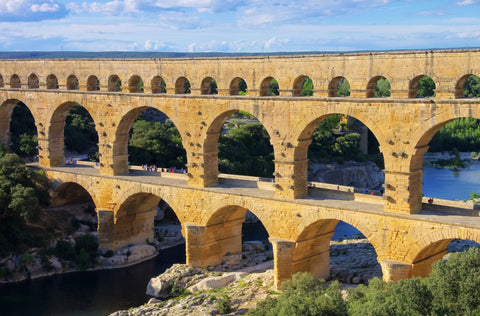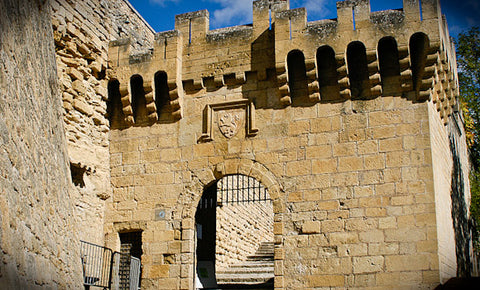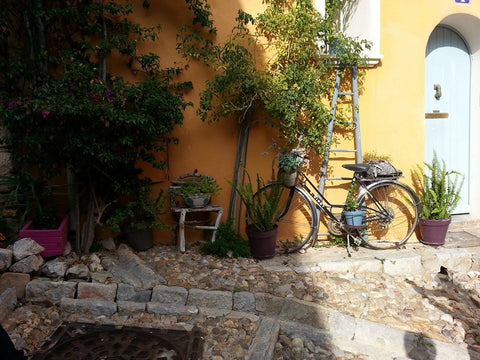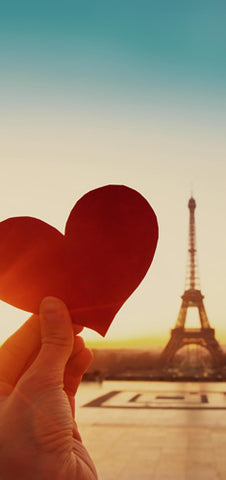By Laura Glendinning
Before high fashion, multi course meals, political intrigues, grand boulevards and palaces, there was, and always will be, the French countryside. All French regions claim to be the ultimate countryside experience. Sorry everyone, but that honor belongs to Provence. It's the history, the food, the informality. It's something. It is Provence.
The Basics - Getting to Provence
There are numerous ways to get to Provence from Paris. High speed rail from Paris to Avignon or Aix, or a meandering drive from Marseille, or rail from Marseille to an inland city and thence to the wonderful countryside of Provence. Personally, I have flown to London from L.A. (via Air New Zealand, one of the best experiences in the air, check it out) and changed planes for Marseille.
|
We Offer Four Different Provence Itineraries
|
Marseille airport is relaxed compared to Paris CDG. It’s the south, which, strangely, in every country seems to translate as “we take it easy here.” Is there a country where the Type A folks are in the south? Italy, the U.S., France. Hmm. From Marseille you can stay coastal of course. Guess where Cannes and St. Tropez are? Provence. Nice? Just east but same idea. The Cote d’Azur (blue coast) is Provence. You can have a very nice little holiday setting up in St. Tropez, Cassis, Juan les Pins, Antibes or Frejus. Swim, eat seafood, go on hikes and drink rose. I have done this and boy do I love the Nice Old Town, in particular.

If you tear yourself away from the lively coast you will be well rewarded with food, wine, history, and what I most recall - the Provencal silence. It’s an ancient cultivated land and once you are ensconced in a hilltop village you might hear the distant whoosh of a highway, but you will mostly hear goats neighing, a very far off tractor coughing, and always you will get the scent of blooms and hay and, in season, lavender.
A Little Background on Provence
Habitation in Provence goes back at least to Neolithic times, thanks to the coastline, climate and game hunting. Rocky soil meant farming was a tough go. The original people there were gradually wiped out by Greeks pressing in from the coast and nomads who showed up from Europe with metal tools and weapons. Tools meant farming was more of an option, and it is said goats and sheep were first domesticated in Provence.
Along the coast the Greeks had established what became Marseille – when they say Old Port there, they mean more than 2000 years. It’s still in use for small boats and day fishermen. Modern cruise ships come in at the very big, and deep, New Port. Inland, the Greeks cultivated olive trees and grape vines in the limestone soil. Wine from that region was considered very superior in ancient times (it is still pretty good now!). You know how it goes when you have a good product. Everyone wants it. And maybe they want your land, your village and your animals, too.
Centuries of tribal fights were quashed a couple hundred years BC when the Romans were called to Provence to help one side out, and not surprisingly decided to stay, making it the first Roman outpost beyond the Alps. Good news, “the Romans are coming to help”. Bad news, ”they aren’t leaving.” As always they built excellent roads (for troop movement) and aqueducts (for water movement) and both innovations created even more commerce, settlement and civilization. Provence, by the way, is called Provence because the Romans referred to it, basically, as “our province.’

As the Roman Empire fell, Christianity spread and waves of occupiers took over Provence once the Romans stopped defending it. Eventually a French pope was chosen and he moved the papacy to Avignon, where it remained for a few decades. You can, and should, visit the Pope’s Palace in Avignon. And you can take a cooking class at the Cardinal’s Palace next door. Such is the march of history. I imagine the old cardinal would be appalled. But the effervescent chef who teaches the class in his very gorgeous stone kitchen would simply laugh.
An absolute staple of Provence are the country markets which are generally every day but Monday (because you can’t get harvesting/picking done by workers on a Sunday). A good day trip will include a market whenever possible.

In November the serious rains come and that might not be the best day to tour a golf club (yes I did that.) We stayed in the club house drinking tepid tea while the golf director sought volunteers to play a few holes.

However with 300 days a year of sun, Provence is much like California, if you added old Roman roads and darling rocky hilltop villages to the mix. France has a designation for small towns of character: “Beautiful Villages of France”. Provence has an awful lot of them. They agree to bury/hide electrical poles, wires and satellite dishes, with cars parked right outside the village. They are a trip back in time and require good knees to walk into, and out of. Not kidding about that, btw. :)

If you are going to survive waves of history, a hilltop village is a good place to be. Attackers, once they have run up a few hills to find you, are positively exhausted. The Luberon valley has quite a concentration of them, including the very famous Gordes, and the slightly less famous but no less gorgeous Menherbes. I all but command people to go to the truffle institute there for at least lunch if not one of their sensory tasting experiences. Unless you don’t like truffles. By the way, I mean the ones the pigs and dogs hunt that taste like the most ultimate mushroom ever, not the chocolate ones you buy in Paris!

Besides truffles, in Provence you are going to eat goat cheese and maybe tour a goat farm, enjoy really good pizza (it’s not that far from Italy) and a more Mediterranean approach to food, meaning olives, olive oil, perfect slices of fruit and much better zucchini and eggplant than I seem to be able to make. This is the veggie part of France more than any other. Meat is a rarity unless you mean lamb sausage. Which is spicy, so watch out.
Provence is dotted with hundreds (yes hundreds) of castles in various states of repair. As castles go, they are kind of humble, compared to the grandeur of the Loire Valley. Da Vinci's ideas took the Loire castle to a very blingy level.
In Provence, the castle was where you stored the valuable animals, grains and the luckier locals when invaders swept through. Most are rather small, with a few stories and a small keep. First floor, animals and valued staff. Second floor, the granary. In many a castle you can see steps worn from centuries of donkeys carrying loads to the upper level. At the top of the castle were the gentry. Hmm. Maybe that's where we get the term "upper class?".
As for lavender, July is the prime month to see the stunning fields. Yet March, or October is most ideal, for temperature (not much is reliably air conditioned), fewer crowds (far fewer) and that peaceful silence I mentioned is easier to come by. Though I have yet to bike the area, electric bike tours are what I would choose. Hills, hills and more hills. With stops for rose of course.

In short, be like a Roman. Come to Provence.
Laura Glendinning is the co-founder of LinkParis.com, the day trips from Paris and Paris tours company. Tour Provence with us.

